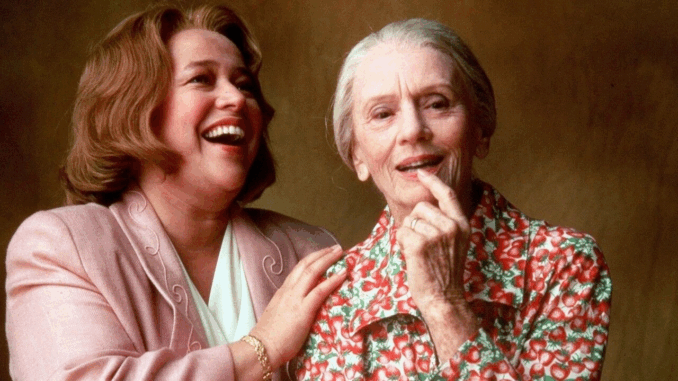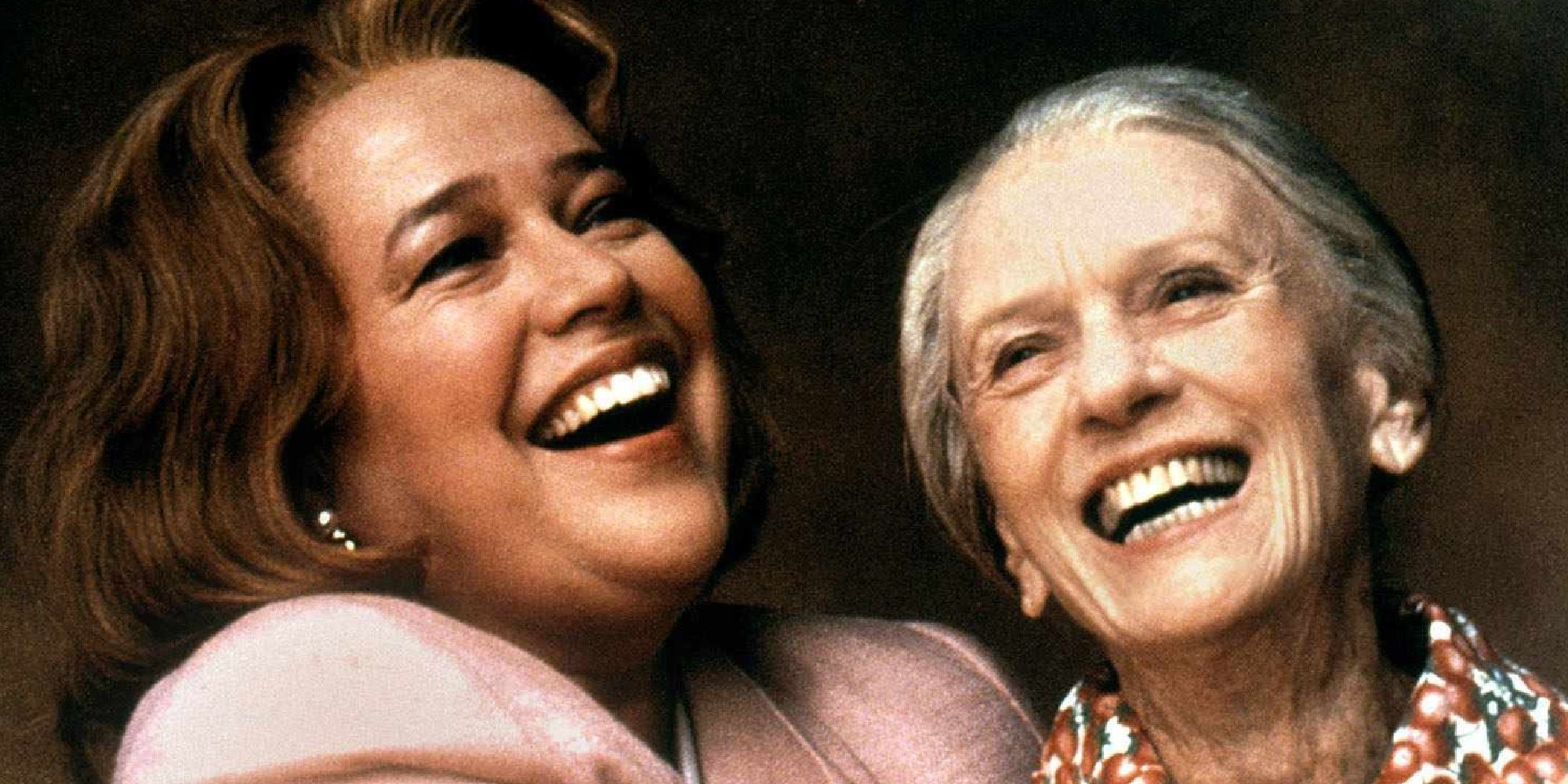
“Strong Southern women” is basically a Hollywood movie genre at this point: Steel Magnolias, Divine Secrets of the Ya-Ya Sisterhood… I could keep going. But one holds a special place in my heart, and that’s Fried Green Tomatoes. There are a lot of reasons — it’s funny; it’s a tear-jerker; it was filmed minutes from the house where I grew up; and it’s a romantic (if sad) Southern queer love story. But standing on the edge of middle age, I rewatched it and found a new reason to love it: Evelyn Couch is kind of a perimenopausal icon.
If you’ve never seen Fried Green Tomatoes (or you haven’t seen it in a couple of decades), it’s really two stories. We start off in the “present day” — 1991, which now feels about as far away as the moon landing — with Evelyn, played by the iconic Kathy Bates. A somewhat meek woman in her late 40s, she’s visiting her husband’s mean-as-a-snake Aunt Vesta in a nursing home when she meets Mrs. Threadgoode, played by Jessica Tandy.
Mrs. Threadgoode starts telling Evelyn stories about her beloved hometown, Whistle Stop, and the two women who ran the cafe there, Ruth and Edgie. On successive visits, Evelyn starts seeking out Mrs. Threadgoode to hear more about the women.
Now, Idgie and Ruth are great characters. And considering it’s a movie made in 1991, based on a book published in 1987, set partially in the 1920s, it’s pretty amazing just how crystal clear it is that they are queer women in a committed, long-term relationship. (While they don’t exactly spell it out, this food fight scene really tells you everything you need to know.) It’s a great reminder that, despite what some clowns at school board meetings would insist, there have always been queer people in the rural South.
But what caught me on this rewatch was Evelyn.
When we meet her, Evelyn is a bit of a mess. Her husband ignores her in favor of eating dinner in front of the TV while watching baseball. Random young people are downright mean to her at the grocery store. Her kid is out of the house, and she’s going to endless meetings and classes, trying to revive her marriage and figure out what she’s supposed to be doing with her life.
These classes provide some of the funniest moments in the movie. At one point, a seminar leader tells her they’re all gonna take off their underwear and use hand mirrors to examine their vulvas. Evelyn literally falls out of her chair in shock and horror. Also, the friend she’s attending all these classes with is the voice of Doug’s Patty Mayonnaise.
It’s a source of comedy that Evelyn is such a mess, but the movie isn’t mean or cruel about it. If anything, it’s reassuring. At one point, she breaks down crying to Mrs. Threadgoode and then sums up the problem of midlife pretty much perfectly: “I’m too old to be young, and I’m too young to be old.”
Whew, Evelyn.
Who among us hasn’t said some version of that exact thing to a friend? It’s a moment everybody goes through sooner or later, in one way or another.
It’s Mrs. Threadgoode who sorts her out. And not just with her stories about Ruth and Idgie. She’s the person who actually tells Evelyn that she’s probably going through menopause (even if she calls it “the change of life”) and tells her to get on hormones. Maybe we all stumble into a Mrs. Threadgoode on our journey into middle age.
Eventually, Evelyn gets unstuck. She starts exercising, she starts telling her husband what she wants, and she gets a job. Granted, the process is a little chaotic. At one point, her husband walks into their house and discovers Evelyn knocking out a wall with a sledgehammer. A few scenes later, her husband walks into their house and discovers that Evelyn is rebuilding the wall. But that’s relatable, too! Middle age is messy. It takes a while to figure out what’s wrong with your life and what would fix it. Figuring out what you want to do with the rest of your life is a whole process.
Admittedly, as a part of that messy process, Evelyn does have a fit of menopausal rage and totals some girl’s car in the Winn-Dixie parking lot after the girl cuts her off for a parking spot. Evelyn cackles and screams with joy the entire time she’s absolutely wrecking this little red convertible. It’s absolutely wild and unhinged behavior… and it’s cathartic to watch. I now understand why my mom cackled at the line, “Face it, girls — I’m older, and I have more insurance.” Amen to that, Evelyn.

One of the biggest hurdles any parent faces during those challenging toddler years, by far, has to be potty training. It’s a milestone that’s both exciting yet terrifying in equal measure. On the one hand, a life free of diapers and blowouts is finally in sight. However, by the same token, a few new challenges emerge. Accidents and messes are inevitable, leaving you and your household vulnerable to some real high-stakes trial and error. In the end, it’s your child’s attitude that holds the key to success. If they are into the change and prove to be willing participants in the learning process, then potty training can be a breeze. But if they aren’t, or if it’s something they come to fear, it can quickly become a crappy situation — literally.
And while some kids’ shows or movies, such as Daniel Tiger’s Neighborhood, Sesame Street, and CoComelon, can help make the whole potty training ordeal seem fun, there are others that prove to have the opposite effect… like the beloved ’90s film Looking Who’s Talking, Too. As much as I personally love the whole Look Who’s Talking franchise, I would not recommend introducing the sequel to your kiddo while you’re in the throes of potty training. Because it won’t end well — believe me. Here’s why.
If you ask me, that pretty much sums up my argument right there.
The movie served as a sequel to its predecessor hit film, Look Who’s Talking, which starred John Travolta, Kirstie Alley, and Bruce Willis, who voiced the inner dialogue of Baby Mikey. The follow-up project had a similar premise, except now Mikey is a toddler who finds himself in the early stages of potty training. He is hesitant about the process, but soon becomes downright terrified after a fellow toddler friend, Eddie, warns him about Mr. Toilet Man — a mystical figure who resides in the potty and needs to be given your pee and poop. That sounds, well, super gross and scary: two very deadly combos when it comes to getting your own little one to squat on a potty.
Kids Mimic What They See
Understandably, Mikey becomes horrified with the idea and starts envisioning what this mysterious Mr. Toilet Man would look like — as will your own child. In his dreams, Mikey goes to use the potty, and it transforms into this terrifying persona. Mr. Toilet Man is scary looking and mean, and he yells at him to do what he says or he will bite off his butt the next time Mikey sits on him. This causes Mikey to wake up screaming — an appropriate reaction for any kid or adult, to be honest.
Ultimately, Mikey faces his fears and successfully uses the potty once he realizes that Mr. Toilet Man isn’t real, but rather a figment of his imagination. The whole family celebrates, and his parents are extremely proud of him, which is a nice ending to the story. However, the journey getting there honestly isn’t worth the effort. I remember watching this movie as a kid and getting completely freaked out during those scenes. It made me question our own toilet at home, leaving me second-guessing if it was safe to use.
So, if you’re in the process of potty training one of your kiddos or gearing up to tackle the process, do yourself a favor and avoid watching this movie at all costs — or the only thing that will get flushed down the toilet is your chance of success.
